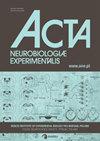A novel insight into the neuroprotective effects ofcannabidiol: maintained apelin/dopamine synthesis, NRF2 signaling, and AKT/CREB/BDNF gene expressions
IF 1.4
4区 医学
Q4 NEUROSCIENCES
引用次数: 0
Abstract
Neuroinflammation is a process associated with degeneration and loss of neurons in different parts of the brain. The most important damage mechanisms in its formation are oxidative stress and inflammation. This study aimed to investigate the protective effects of cannabidiol (CBD) against neuroinflammation through various mechanisms. Thirty‑two female rats were randomly divided into 4 groups as control, lipopolysaccharide (LPS), LPS + CBD and CBD groups. After six hours following LPS administration, rats were sacrificed, brain and cerebellum tissues were obtained. Tissues were stained with hematoxylin‑eosin for histopathological analysis. Apelin and tyrosine hydroxylase synthesis were determined immunohistochemically. Total oxidant status and total antioxidant status levels were measured, and an oxidative stress index was calculated. Protein kinase B (AKT), brain-derived neurotrophic factor (BDNF), cyclic‑AMP response element‑binding protein (CREB) and nuclear factor erythroid 2‑related factor 2 (NRF2) mRNA expression levels were also determined. In the LPS group, hyperemia, degeneration, loss of neurons and gliosis were seen in all three tissues. Additionally, Purkinje cell loss in the cerebellum, as well as neuronal loss in the cerebral cortex and hippocampus, were found throughout the LPS group. The expressions of AKT, BDNF, CREB and NRF2, apelin and tyrosine hydroxylase synthesis all decreased significantly. CBD treatment reversed these changes and ameliorated oxidative stress parameters. CBD showed protective effects against neuroinflammation via regulating AKT, CREB, BDNF expressions, NRF2 signaling, apelin and tyrosine hydroxylase synthesis.对大麻二酚神经保护作用的新认识:维持芹菜素/多巴胺合成、NRF2信号传导和AKT/CREB/BDNF基因表达
神经炎症是一个与大脑不同部位神经元退化和丧失有关的过程。其形成过程中最重要的损伤机制是氧化应激和炎症。本研究旨在探讨大麻二酚(CBD)通过各种机制对神经炎症的保护作用。研究人员将 32 只雌性大鼠随机分为 4 组,分别为对照组、脂多糖组、脂多糖 + CBD 组和 CBD 组。给药六小时后,大鼠被处死,取其大脑和小脑组织。组织经苏木精-伊红染色后进行组织病理学分析。用免疫组化法测定凋亡素和酪氨酸羟化酶的合成。测量总氧化状态和总抗氧化状态水平,并计算氧化应激指数。还测定了蛋白激酶B(AKT)、脑源性神经营养因子(BDNF)、环AMP反应元件结合蛋白(CREB)和核因子红细胞2相关因子2(NRF2)的mRNA表达水平。在 LPS 组中,所有三个组织都出现了充血、变性、神经元缺失和胶质增生。此外,在整个 LPS 组中还发现了小脑中普肯耶细胞的丢失以及大脑皮层和海马中神经元的丢失。AKT、BDNF、CREB和NRF2的表达、凋亡素和酪氨酸羟化酶的合成均显著下降。CBD 治疗逆转了这些变化,并改善了氧化应激参数。CBD通过调节AKT、CREB、BDNF表达、NRF2信号传导、凋亡素和酪氨酸羟化酶的合成,对神经炎症具有保护作用。
本文章由计算机程序翻译,如有差异,请以英文原文为准。
求助全文
约1分钟内获得全文
求助全文
来源期刊
CiteScore
2.20
自引率
7.10%
发文量
40
审稿时长
>12 weeks
期刊介绍:
Acta Neurobiologiae Experimentalis (ISSN: 0065-1400 (print), eISSN: 1689-0035) covers all aspects of neuroscience, from molecular and cellular neurobiology of the nervous system, through cellular and systems electrophysiology, brain imaging, functional and comparative neuroanatomy, development and evolution of the nervous system, behavior and neuropsychology to brain aging and pathology, including neuroinformatics and modeling.

 求助内容:
求助内容: 应助结果提醒方式:
应助结果提醒方式:


